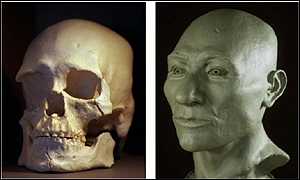Indian DNA links to 6 'founding mothers'
Those women left a particular DNA legacy that persists to today in about about 95 percent of Native Americans, researchers said.
The finding does not mean that only these six women gave rise to the migrants who crossed into North America from Asia in the initial populating of the continent, said study co-author Ugo Perego.
The women lived between 18,000 and 21,000 years ago, though not necessarily at exactly the same time, he said.
1) That the Paleo-Indians exterminated the megafauna when they arrived in 12,000 BC. That isn't likely if they coexisted with the megafauna for the prior 8,000 years.
2) That Kennewick Man or other alleged non-Indians inhabited the Americas before the Paleo-Indians.


7 comments:
"1) That the Paleo-Indians exterminated the megafauna when they arrived in 12,000 BC. That isn't likely if they coexisted with the megafauna for the prior 8,000 years."
I don't follow... With relatively low numbers of Natives, such exterminations could have indeed taken a very long time to happen.
Writerfella here --
Luckily for DMarks, Native ancestors must have arrived in groups of less than two or four at a time and therefore wouldn't have killed or eaten mammoths in quantities greater than five. People don't move like that! They travel in great groups, masses, crowds, or they simply would not have survived. They were TRIBES, remember? Tribes aren't Ozzie and Harriet and David and Ricky! They were numerous and acted numerously, therefore. THE TRIBES FOLLOWED THE MEGAFAUNA INTO THE AMERICAS, or why else would it have happened? Oh, by the bye, if Kennewick Man is out of a job, does that mean that Patrick Stewart had better file for British unemployment insurance?
All Best
Russ Bates
'writerfella'
The theory claims that humans burst on the scene after the last Ice Age ended 12,000 or 11,000 years ago. The megafauna had no defenses against the new predators so the humans quickly wiped them out.
This story falls apart if the humans were around for the previous 8,000 years. The megafauna would've had time to adapt and reach an equilibrium with the newcomers.
For more information:
http://en.wikipedia.org/wiki/Holocene_extinction_event
In broad usage, the Holocene extinction event includes the notable disappearance of large mammals, known as megafauna, by the end of the last glacial period 9,000 to 13,000 years ago. Such disappearances have been considered as either a response to climate change, a result of the proliferation of modern humans, or both.
During the last 50,000 years, including the end of the last glacial period, approximately 33 genera of large mammals have become extinct in North America. Of these, 15 genera extinctions can be reliably attributed to a brief interval of 11,500 to 10,000 radiocarbon years before present, shortly following the arrival of the Clovis people in North America. Most other extinctions are poorly constrained in time, though some definitely occurred outside of this narrow interval.
@Writerfella: "Native ancestors must have arrived in groups of less than two or four at a time and therefore wouldn't have killed or eaten mammoths in quantities greater than five"
How big were these people, for which a group of 2 to 4 could eat as many as 5 mammoths at a time? Not sure, but perhaps their slightly smaller descents can be found in modern Chinese buffet restaurants for hours at a time.
Rob: I tend to think that the humans and megafauna existed alongside each other for much longer than that.
Writerfella here --
Of course they did. BUT -- did Natives develop a taste for giant sloths or Sabre-Toothed Cats or giant armadillos or Dire Wolves or even the giant short-faced bears of that era, as well as for giant bison and mastodons and mammoths? Unlikely. Therefore, the extinctions so listed came about NATURALLY, not unnaturally or through predation. Adaptation takes place by many factors, else horses and camels still would have existed in the Americas when Natives arrived here...
All Best
Russ Bates
'writerfella'
Re "The tribes followed the megafauna into the Americas": Actually, many of the large species evolved in the Americas. They didn't evolve elsewhere and migrate to the Americas.
Species such as the woolly mammoth migrated to the Americas, but I think that was well before the last Ice Age. I think mammoths were essentially indigenous to the Americas by the time humans arrived.
But the rest of Russ's supposition may be true. As I said, the evidence is pointing away from humans causing the mass extinctions and toward the environment causing them.
This discussion of mammoths raises a point I haven't seen addressed anywhere. As one website notes, "Mammoth remains have been found in Europe, Africa, Asia, and North America." The question is: Did they die out everywhere at the same time? Or did they die out only in the Americas at that time?
If they died out everywhere, it would tend to rule out the "Paleo-Indians hunted them to extinction" theory. If they died out only in the Americas, it would tend to support that theory. So which is it?
Post a Comment